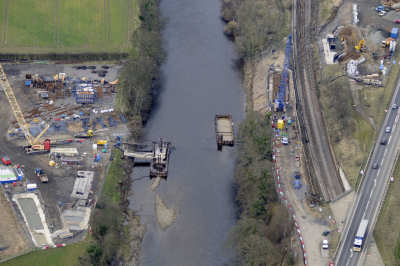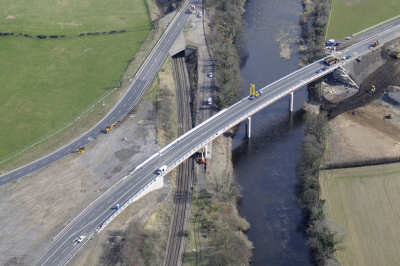Haydon Bridge Bypass |
|
Whole Project award
Project Team
Client: Highways
Agency
Design: CVC Highway Solutions
Construction: CVC Highway Solutions
The Project
The £27 million Haydon Bridge Bypass has re-routed the A69 Trunk Road around the southern edge of the town. The overall scheme length is 2.90 kilometres. The bypass is a 7.30 metre wide single carriageway (S2) with 1 metre edge hardstrips, resulting in an overall carriageway width of 9.30 metres. The route extends between Crossley Burn in the east and West Rattenraw.
Advance works were carried out to ensure that wildlife and their habitats, including fish, were not disturbed outside the permitted seasons. Diversions of utility services were carried out by the statutory authorities as required to co-ordinate with the main works.
A major feature of the scheme is a new multi-span viaduct structure crossing the River South Tyne, and the Newcastle to Carlisle railway line, on the west side of Haydon Bridge. A new structure, Gees Wood Bridge was also constructed where the bypass crosses Langley Burn at Gees Wood. The Cemetery Road Bridge and East Land Ends Bridge provide the underpasses at Esp Hill and East Land Ends to take the side roads under the bypass.
The objectives of the scheme are to ease congestion and to address safety concerns arising from conflicting pedestrian and vehicle movements. The scheme also aimed at reducing community severance and improving the environment for residents, pedestrians, and cyclists in Haydon Bridge.
Land Use & Landscape Issues
Local and reclaimed stone was used within the works wherever possible to retain the character of the landscape and to give the new structures a more fitting appearance. Whilst not structurally feasible to build the new bridges from local stone, they were designed to be simple and light to minimise their visual intrusion into the floodplain landscape. Redundant sections of the old A69 were removed and replanted, to reduce the significance of roads within the local landscape, and trees were planted alongside the main street in Haydon Bridge following de-trunking of the road thus reducing the width of the street further slow traffic. Introduction greenery into the village centre was also carried out.

Ecology and Biodiversity
A number of protected species were present within the footprint of the proposed scheme, requiring substantial mitigation measures to be put in place – wildlife included bats, reptiles, fish, otters, red squirrels, brown hares and badgers!Vegetation clearance was kept to the absolute minimum required for the project to minimise disturbance and many new trees, hedgerows and shrubs were planted as part of the landscaping works to compensate for and enhance the habitat. Flightlines for bats were maintained during construction through the use of bunting and wire mesh whilst new hedgerows were maturing. To minimise the risk of bats flying over the road and also to reduce disturbance to otters and fish, the bridge parapets were made solid to minimise light spillage, creating an area of darkness under the bridge, which is more attractive to bats than the lit section of carriageway. Five artificial otter holts were created from logs produced during tree felling activities. Badger fencing was erected to direct badgers to the underpasses or the farm access – this was adapted with a mesh along the lower section to also prevent brown hares from crossing the carriageway.

Energy and Carbon
The majority of energy and carbon requirements of the scheme once in operation will result from the maintenance requirements. A Maintenance and Repair Strategy was developed to assess the requirements and minimise them wherever possible. This has resulted in a number of considerations being incorporated into the scheme, such as: grading out of embankments, wherever possible, to minimise the requirement for safety barrier and associated maintenance; use of higher grade reflective sign material to minimise lighting requirements; use of woodcrete bat boxes which have no ongoing maintenance requirements; and aluminium parapets on all structures to avoid the need for maintenance painting.
Material Use
All timber used in both the temporary and permanent works was specified and supplied from a legal and sustainable source, certified under either the FSC (Forest Stewardship Council) or PEFC (Programme for the Endorsement of Forest Certification) Chain of Custody standards.
Waste Management
The scheme was designed to achieve a cut and fill balance between the excavated soil and rock and the construction of embankments and landscape mounds, which also assisted the mitigation of environmental impacts – approx. 250,000m3 in total. All demolition material produced on site was incorporated into the project – planings and kerbs were crushed on site and used as Class 1A fill material; stone from existing walls was stockpiled and reused; fence rails and posts were mulched on site along with cleared hedgerows and incorporated into the landscaping works. 100% of unused materials at project completion were sold, donated or transferred to other contracts.

Transport
The Haydon Bridge bypass was designed with the aims of easing congestion in the village and addressing safety concerns from conflicting pedestrian and vehicle movements, but also to reduce community severance and improve the environment for residents, pedestrians and cyclists in Haydon Bridge. By removing a significant volume of traffic from the centre of Haydon Bridge, the scheme has resulted in a significant improvement in traffic noise, vibration and air quality for a considerable number of residents, with only a small number adversely affected by the scheme. The design of the bypass ensured that as much of the new road as possible was in cutting to act as a noise mound, with false cuttings created where this was not possible.
Relations with the Local Community and other Stakeholders
A Public Relations Strategy was developed by the project team, to assist the public and other stakeholders to understand and value the aims of the Haydon Bridge bypass project. A Community Liaison Officer was appointed for the duration of the contract to act as a focal point for all consultation, information requests and complaints, to manage and organise consultation events, exhibitions and site visits. This was carried out to establish and maintain liaison links with all interested parties and to promote the scheme. Communications were conducted through a wide-ranging number of methods, including: a project extranet site; local meetings and exhibitions; letters to directly affected parties; health & safety presentations at local schools; newsletters; and press articles. Throughout both the design and construction stages, communications were fully assessed and adaptations made where considered appropriate – for example, the section of highway at Esp Hill was realigned following public consultation responses.

